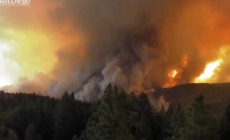-
Serial killer who wanted to be mafia hit man given life in prison after death sentence is overturned - 15 mins ago
-
Justin Timberlake’s lawyer claims police made ‘significant errors’ during star’s DWI arrest - 21 mins ago
-
Damages to college athletes range from few dollars to $1M-plus under settlement - 26 mins ago
-
Kamala Harris Dealt Triple Swing State Polling Blow in One Week - 34 mins ago
-
Exciting AI tools and games you can try for free - 39 mins ago
-
‘Firenado’ spotted above explosive Park fire near Chico - 54 mins ago
-
Mich. woman accused of fatally injuring her girlfriend’s infant after getting drunk while babysitting - 58 mins ago
-
Christina Hall refutes estranged husband Josh Hall’s ‘blindsided’ by the divorce claim - about 1 hour ago
-
Tua Tagovailoa inks four-year, $212.4M extension with Dolphins, $167M guaranteed | Speak - about 1 hour ago
-
Dog Returned Twice Hasn’t Given Up Hope Despite 1,244 Days At Shelter - about 1 hour ago
Photographs contain a celebration and a caution
Old Father Time and Mother Nature have joined in pleasing harmony during the passing millennia to create something special on the island of Borneo, home to striking landscapes and plentiful wildlife. Ideally, go and see, or at least put it on your bucket list, but for the moment live vicariously and simply savour the splendour displayed in Charles Ryan’s coffee-table book of glorious photographs.
On the front cover is the elusive Bornean clouded leopard, one of 221 land mammals including the proboscis monkey and the declining orangutan to be found on this, the world’s third-largest island. In raw figures, locals and visitors can also delight in more than 15,000 species of flowering plants such as the corpse lily that produces the largest flower on Earth, more than 600 species of birds including eight amazing types of hornbill, and hundreds of equally photogenic reptiles, amphibians and freshwater fish.
Equally, Ryan’s trails through Borneo in pursuit of dazzling nature are accompanied by tales and beliefs of the island’s indigenous communities. One article of faith is that it is completely taboo in some South-East Asian societies to ridicule or laugh at animals, an action thought likely to endanger the safety of the whole populace. Some believe the offender may even be turned to stone. So where creatures are concerned, respect is absolute.
Charles Ryan leads the way here. An avid wildlife photographer, he has visited more than 50 countries primarily in Asia, Africa and South America. After studying environmental science in college, he moved to Borneo in 2008 to work on conservation and community development, including forest restoration, eco-tourism and efforts to curb illegal poaching and logging.
He has worked extensively to document the flora and fauna of Borneo, and his photographs have been widely published. Also, as a professional guide for a decade and more he is happy to share the expertise gained from his many years spent exploring the big island, its almost 750,000 square kilometres making it smaller only than Greenland and New Guinea.
His focus is to create alternative livelihoods through forest restoration projects and community tourism initiatives. Ryan trains individuals to become nature guides, believing this to be an invaluable skill to promote conservation. As an expert naturalist and having travelled extensively, he uses his images to educate people on the importance of tradition and conservation. He also runs wildlife photography workshops throughout Asia.
“Borneo, From Trails To Tales” contains around 160 pages of full-colour photographs that do due justice to the blazing colours and diversity of this tropical island lying astride the equator and shared by three countries. These are the Indonesian province of Kalimantan that occupies 70 per cent of Borneo, the East Malaysian states of Sabah and Sarawak, and the tiny sultanate of Brunei Darussalam.
The island is bounded by the South China Sea to the north-west, the Sulu Sea to the north-east, the Celebes Sea to the east and the Java Sea to the south. Topping it all is the 4095-metres-tall Mount Kinabalu, Malaysia’s highest peak, in Sabah. As Ryan notes, Kinabalu is an integral part of the state’s cultural and belief system, being beloved, admired, revered and steeped in legend.
One of the many stories about its name comes from the Kadazandusun people who say it derives from “Aki Nabalu”, “aki” referring to ancestor or grandfather and “nabalu” a mountain. It is the resting place of departed souls, who are its guardians, and must have utmost respect. Your behaviour there will determine the smoothness of your journey.
Another ancient folklore believes the name Kinabalu derives from the term “Cina Balu”, meaning Chinese widow. Legend has it that a Chinese prince searched for a luminous jewel guarded by a ferocious dragon atop the mountain. During his quest he married a native maiden but soon returned to his homeland. She, heartbroken, would wander the peaks for a bird’s eye view of the ocean in anticipation of his return. Over time she turned to stone and stands eternally as one of the many peaks of Kinabalu.
The Gomantong Caves are renowned for valuable edible birds’ nests, collected in harvesting months. Batu Tulug caves contain more than 100 carved wooden coffins dating back 250-plus years and decorated with carvings of animals such as buffaloes, crocodiles and snakes, reflecting myths and legends.
One of those spectacular hornbills is the Helmeted Hornbill, and on the rare occasion when it is spotted in desolate graveyards the Kadazan ethnic group takes heed of its tudun-tudun cry as a sign that there may soon be a death in the community.
Other multi-hued birds include the Bornean Bristlehead, the White-crowned Sharma and the Pale-faced Bulbul. The amazing plumage of the Rhinoceros Hornbill adorns a bird that some believe is a messenger between humans and gods. It has long been revered by the indigenous communities of Sarawak.

Read also of ceremonies such as the Tolak Balak, where the Orang Sungai people, who mainly live along the Kinabatangan river in the east coast of Sabah, make food offerings of boiled eggs and coloured rice , decorated with flags and placed on small banana-leaf boats and set afloat on the river. This is to ensure that the year’s river activities will be plain-sailing, but as Ryan points out, it is a dying tradition as the Orang Sungai turn more to Islam in favour of animistic practices.
Yes, we are in the modern world, and for all of Nature’s munificence in the depths of the rainforests– pygmy elephants, white crocodiles, the big-eyed Horsfield’s Tarsier (ghost monkey), the civet (leopard cat), the armoured pangolin, the bearded pig, crested dragons (a lizard), horned frogs, sun bears, gibbons – there is a flip side too.
Before plunging into the photos of these spectacular creations of Nature, read the Foreword by Dr. Catherine Workman, Senior Director of Research and Conservation Grants at the National Geographic Society. As she notes, there’s something about this island that is both rugged and romantic, wild yet strangely serene, much explored but still plenty undiscovered.
It is a paradise and Charles Ryan’s visual notebook offers a rare and exclusive glimpse while also revealing dynamic change, Dr. Workman states. Here is one of planet Earth’s biologically richest but most threatened regions. And those numbers quoted above cover only the known species, for there are thousands more still unknown to science.
“Borneo is struggling to find balance between the inevitable forces of modern development and the internal and external desires to preserve its cultural past and ecological wealth,” she says. “Ryan reveals this struggle through intimate and captivating photographs.”
A case perhaps of join him now on those exciting trails, if you can. If not, skip the humidity and creepy crawlies, and read, look and appreciate from your armchair. Proceeds of the book go towards a community-based tourism initiative in Sayap Village, Kota Belud, Sabah State.
Email: info@stickyricetravel.com
Source link































